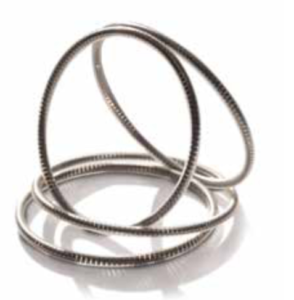
Fluorinated ethylene propylene (FEP) is one of the most popular jackets for encapsulated rings used in cryogenic, corrosive environments, and even FDA-approved food grades. It is well-known by many of the trade names Teflon FEP, Neoflon FEP, and Dyneon FEP. FEP encapsulated helical springs are one type of these seals.
Let’s take a closer look at what an FEP encapsulated helical spring is, the properties of these seals, and the benefits of using them.
What is an FEP Encapsulated Helical Spring
FEP Helical spring seals are created from helical springs. These are elastic coiled mechanical devices. Most consumers are used to seeing helical springs in equipment and devices that store and release energy.
A helical spring seal provides sealing solutions for industries operating in extreme conditions. These seals provide a gas-tight sealing system that meets environmental regulations and reduce fugitive emissions.
FEP encapsulated helical springs seals are housed within a durable, chemical jacket made from fluorinated ethylene propylene. The FEP jacket allows the spring seal to work in chemically corrosive environments or extreme temperatures.
What are the Properties of FEP Encapsulated Springs
FEP encapsulated helical spring seals’ properties make them ideal for use in extreme conditions. A wide variety of industries can use these spring seals to meet their needs.
| Property | Test Method | Units | Results |
| Encapsulation Max Service Temperature | 8,000-hour aging tests | °C / °F | 204 / 400 |
| Encapsulation Tear Strength | ASTM D1004 (Initial) | N / Kg | 2.65 / 0.270 |
| Encapsulation Tensile Strength | ASTM D638 @ 24°C / 75°F |
PSI / Bar / MPa | 3,400 / 234 / 23.0 |
| Encapsulation Impact Strength | ASTM D256 @ 24°C / 75°F |
J/m2 | No Break |
| Encapsulation Hardness | ASTM D2240 | Shore | 56 |
| Encapsulation Specific Gravity | ASTM D792 | g/cm3 | 2.15 |
| Encapsulation % Elongation @ Break | ASTM D638 @ 24 °C / 75°F |
% | 325 |
| Encapsulation Flex Modulus | ASTM D790 | PSI / Bar / MPa | 85,000/5,860 / 586 |
| Encapsulation folding Endurance | ASTM D 2176 | Cycles | 100,000 |
| Encapsulation Ignition Temperature | Vul045 | °C / °F | ≥530 / ≥986 |
| Encapsulation Color | Visual | N/A | Off Clear |
| Moisture Absorption | Vul046a | % | <0.01 |
Advantages of FEP Encapsulated Spring Seals
FEP encapsulated spring seals have many advantages for industrial settings such as cryogenics, aerospace, and oil. It has some of the same advantages as using PFA encapsulated seals.
FEP encapsulated helical spring seals’ properties make them ideal for use in extreme conditions. A wide variety of industries can use these spring seals to meet their needs.
The FEP jacket protects from corrosive chemicals. FEP has an excellent resistance rating for several chemicals, including the following.
- Gasoline
- Hydrochloric Acid (1-5, 20, and 30%)
- Isobutyl Alcohol
- Isopropyl Alcohol
- Propane Gas
- Sulfuric Acid ( 1-6, 20, 60, and 98%)
- Sulfuric Hydroxide (1 and 50%)
FEP also has a wide operating range. It works in a temperature range of -420°F (-251°C) to 400°F (204°C). At cryogenic temperatures, FEP encapsulated helical springs remain flexible. This flexibility makes it preferable to O-rings in a cryogenic environment.
The FEP encapsulated helical springs have low friction. It gives them a minimal stick-slip behavior. A low compression set allows the seal to return to its original shape after deformation.
Best FEP Encapsulated Helical Springs
FEP encapsulated helical seals have several advantages in cryogenic and corrosive environments. They withstand temperatures as low as -251°C (-420°F) and are flexible even at low temperatures.
Advanced-EMC will work with you to find the encapsulated helical spring solution your application needs, from FDA-approved solutions for use with food processing equipment or a reliable, cryogenically compatible solution for a rocket. Contact us today to learn more.
FAQ
Is FEP silicone?
No, FEP stands for fluorinated ethylene propylene. A Teflon coating protects the seal from hazardous conditions such as extreme temperatures and chemical environments. FEP can encase silicone rings, but it is not silicone itself.
Is FEP the same as PTFE?
No, while both are Teflon substances, there are several key differences. FEP is better with gas and vapor permeability, while PTFE has a lower coefficient of friction.
